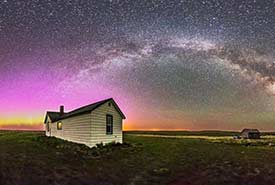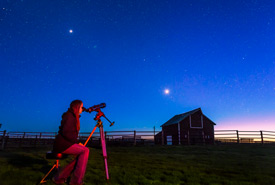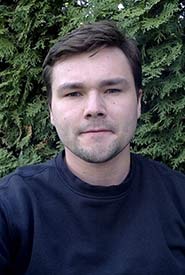Sights of the sky: Stargazing and nighttime photography in Saskatchewan

Night sky above Old Man on His Back Prairie and Heritage Conservation Area, SK (Photo by Alan Dyer)
When the sun sets on our prairie province, the night sky comes alive with some pretty magnificent sights. Despite my extremely limited knowledge of astronomy and stargazing, I often find myself gawking in wonder at evening skies. Luckily for me, and many others, the Nature Conservancy of Canada’s (NCC’s) upcoming Introduction to Stargazing and Nighttime Photography webinar should provide some tips and guidance on how to get the most out of night viewing. Chris Beckett and Dale Boan will be the speakers at the webinar, and I had the chance to chat with both experts prior to the event.
Chris Beckett’s fascination with astronomy started when he was just a child and has grown to become a steady passion in his adult life. Based out of Regina, he has written for the Royal Astronomical Society of Canada and taught non-credit astronomy classes at the University of Regina.

Observing Venus on a prairie spring night (Photo by Alan Dyer)
When I think of stargazing, I imagine someone peering into a telescope to view a night sky. While a useful tool for experienced astronomers, Chris explained to me that telescopes aren’t mandatory for amateur enthusiasts. Their steep learning curve and high price can be daunting to those just starting out, so he recommends binoculars as a starting point. Binoculars have powerful lenses that are more than capable of magnifying our stratosphere and are a cost-effective alternative to a telescope. He highlights that you don’t need to spend a ton of money to be able to have a complete stargazing experience.
Where to go for the experience?
We’ve all heard of shooting stars, constellations, the milky way and northern lights. But how do we go about actually spotting these events in the sky? Chris points me to a best-selling book called NightWatch by Terence Dickinson, which is widely available online. The book provides readers with resources and charts that are good starting points for beginners. As for locations in Saskatchewan that are ideal for viewing? You likely don’t have to travel very far. Chris explained to me how light pollution from cities can make it hard to have clear views of the night sky, and that rural settings where there is little light pollution make for great viewing sights. A 15-minute drive outside most cities in Saskatchewan can make all the difference when searching for clarity in the night’s sky.
Basic gear for nighttime photography
Like most people, whenever I see something interesting, I want to take a photo or video of it. But when dealing with night settings and dark skies, it can be difficult to get decent results. Dale Boan is an experienced nighttime photographer based out of Saskatoon, and he has plenty of tips and experience to share. He says getting started with nighttime photography doesn’t require a lot of expensive gear, but having a basic camera such as an iPhone or a DSLR and a tripod is a good start. He adds that patience and practice are things to consider when photographing night skies.
Safety first
Safety is of the utmost importance when heading out for these nighttime activities. Dale mentions the importance of planning beforehand and making your friends or family aware of where you’re going. Bringing water, food and a phone are also important to remember. He adds that ensuring you aren’t trespassing, and parking in a safe location are proper precautions to make when venturing out on gravel roads.
While stargazing and nighttime photography are year-round activities, summer is an ideal time to get out thanks to the warm weather. So, if you’re looking for a new activity to try out this summer, check out NCC’s Stargazing and Nighttime Photography Webinar recording for tips and tricks, here.


